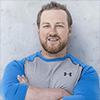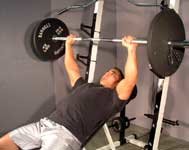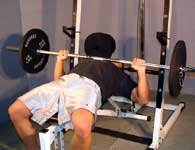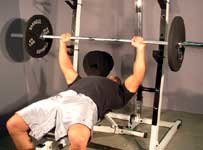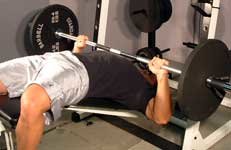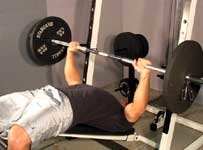Introduction To Chest Building 101
A new course is available at Weik University on building a massive chest. Those interested in sitting through an easy course, no need to look any further because class has just begun.
Everyone is guaranteed an "A" for the course as long as you sit through the course and pay attention (you can take notes if you wish). From there, all you have to do is take what you learned from the course and utilize it in the gym for massive chest gains.
Let's start with the basics of Chapter 1 and then get into more detail later on in the course.
Chapter 1: Anatomy Of The Chest
Let's start off by explaining the anatomy of the chest. It's not very complicated and not much to it. Once you understand how the chest works, you will find it easier to visualize your chest workouts.
The chest is made up of two muscles:
- The pectoralis major
- The pectoralis minor
The pecs are found attached to the humerus of the arm, right near where the shoulder joint is. They then run across the front of the body and originate on the breastbone (picture a chicken breast).
The pectoralis major is attached to the front of the body on the rib cage. The pectoralis minor is found underneath the pectoralis major. It originates on the ribs and attaches up to the scapula, specifically at the coracoid process.
The pectoralis major brings the humerus across the body while the pectoralis minor moves the shoulders forward. Together, you get the bench press movement.
Like I said before, once you understand how everything works it makes it much easier to visualize the muscle fibers contracting during each set. When you have a good mind-muscle connection you get more out of each rep.
Too many people try to load on a weight that they can't handle and end up using more accessory muscles rather than the chest alone. That's fine if you are trying to impress chicks, but in terms of results it's not efficient.
Chapter 2: Different Parts Of The Chest
When hitting the chest you have 3 different areas that you want to hit hard with compound movements. You have the upper chest, mid chest, and lower chest.
The Upper Chest
The upper chest is something that some gym rats forget about. The best exercise for hitting the upper chest is incline barbell presses. For this you want to have the bench on an incline where you can specifically feel it working your upper chest.
Different people feel the exercise at different angles (45 degrees works for most people)—but the best thing to do is try different angles to see what works for you.
If you feel the exercise more towards the middle of your chest then you have the angle too low and it will feel more like a flat bench press. On the flip side, if you feel the exercise more in your shoulders, then you have the angle too high and you need to decrease the angle.
The Mid Chest
The mid chest is hit with the famous exercise—the bench press. Everyone does it in the gym (unless you are injured, have a disability, or simply have no idea what you are doing in the gym).
Too many people are in the gym trying to impress everyone with how much they can bench, yet more than half of them are doing the exercise incorrectly in which they can cause serious injury to themselves.
The famous saying, "What do you bench?" is said around the gym more than any other saying-I cringe at the sound of it. Not because I don't care what they bench, but because I know that person is one of the many that I mentioned above that are probably executing the exercise incorrectly.
So let me say it once and get it over with... It's not how much weight you can lift, leave your ego at the door - concentrate on feeling the weight and using the correct form. Another exercise that involves no weights that hits the mid-chest is the push-up. These are great for if you can't get to the gym or you want to pump up a little bit.
The Lower Chest
The lower chest I believe is the most neglected portion of the chest. When you look at the best chests in bodybuilding you notice from top to bottom the chest is fully developed and full.
If someone neglects the lower portion of their chest you will notice fullness in the upper half but below mid-chest they will be flat and without the roundness at the bottom portion. Doing decline presses as well as dips can develop the lower chest.
Chapter 3: Different Chest Exercises
- Flat Barbell Bench Press
- Flat Dumbbell Bench Press
- Incline Barbell Bench Press
- Incline Dumbbell Bench Press
- Decline Barbell Bench Press
- Decline Dumbbell Bench Press
- Flat Bench Dumbbell Flyes
- Incline Bench Dumbbell Flyes
- Decline Bench Dumbbell Flyes
- Smith Machine Flat Bench Press
- Smith Machine Incline Bench Press
- Pec Deck
- Cable Machine Flat Bench Fly
- Cable Machine Incline Bench Fly
- Bodyweight Push-ups (different hand positions available)
- Weighted Push-ups (different hand positions available)
- Bodyweight Incline Push-ups on the Stability Ball (different hand positions available)
- Bodyweight Dips
- Weighted Dips
- Pull-overs
Chapter 4: Mass Building Chest Workouts
Workout 1
- Incline Barbell Bench Press: 3 x 8-12
- Flat Barbell Bench Press: 3 x 8-12
- Decline Barbell Bench Press: 3 x 8-12
- Incline Bench Dumbbell Fly: 3 x 15
- Flat Bench Dumbbell Fly: 3 x 15
 Click Here For A Printable Log Of Workout 1.
Click Here For A Printable Log Of Workout 1.
Workout 2
- Incline Dumbbell Press: 3 x 8-12
- Flat Dumbbell Press: 3 x 8-12
- Decline Dumbbell Press: 3 x 8-12
- Incline Cable Fly: 3 x 15
- Flat Cable Fly: 3 x 15
 Click Here For A Printable Log Of Workout #2.
Click Here For A Printable Log Of Workout #2.
Workout 3
- Incline Dumbbell Press: 3 x 8-12
- Flat Barbell Bench Press: 3 x 8-12
- Dips: 3 x 8-12
- Incline Dumbbell Fly: 3 x 15
- Machine Fly: 3 x 15
 Click Here For A Printable Log Of Workout #3.
Click Here For A Printable Log Of Workout #3.
Workout 4: Bodyweight Workout
- Bodyweight Incline Push-up on Stability Ball: 5 x 8-12
- Bodyweight Push-up: 5 x 8-12
- Bodyweight Dips: 5 x 8-12
 Click Here For A Printable Log Of Workout #4.
Click Here For A Printable Log Of Workout #4.
Workout 5: Smith Machine Workout
- Smith Machine Incline Bench Press: 5 x 8-12
- Smith Machine Flat Bench Press: 5 x 8-12
- Smith Machine Decline Bench Press: 5 x 8-12
 Click Here For A Printable Log Of Workout #5.
Click Here For A Printable Log Of Workout #5.
Course Conclusion
When it comes down to it you want to focus on the mind-muscle connection. You should really feel each rep and feel the muscle working. If you don't feel an exercise in your chest, then you are probably doing it wrong or are using a weight that you can't handle and are using more than just your chest.
Make sure you are hitting each part of the chest equally (unless your chest isn't balanced then you need to work on that section more). Focus on compound movements for the upper, mid, and lower chest. Then utilize shaping movements such as flyes to finish out your chest workout.
Most of all have fun with your workouts. If you aren't having fun, then what's the point? Utilize what you learned in this course and see where it takes you. Good luck and see you at graduation!
